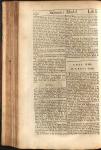This chapter hasn't been proofread yet.
I. The Names. It is called in Greek, Ttfjncr Zyeji& : In Latin, Geranium agrcjie : and m.English), Field Cranes-bill.
II. The Kinds. The Field Cranes-bill is manifold, but those which we design under that Name, are, . Geranium agreste, Geranium Viohceum, field, _r Violet colored Cranes-bill. 2. Geranium Geut.c folio inodorum, Field Cranes-bill without Smell _·, of this we have discoursed in Chap. 160. Seft. 4. 7. Geranium Columbinum, Doves-foot. 4. Geranium Robert i.num, Herb Robert > of which two bit we shall speak in some of the Chapters following
III. The Description. It has a Root which is /fc/V/fc |juice and Essence, but very much weaker, and may m{ woody, hiving some few firings adjoining there- be given to those who cannot be induced to take
them. However you make thereof an exceedi
to, and is wholly red, both within and without, not fuelling Jo strong <u the Root of Herb Robert: from this Root rise up several fender hairy reddish Stalks, about two or three feet high ; at the Joints of which grow Leaves, upon shorter, yet reddish footstalks. The Stalks spread themselves out also into other small Branches, whereon are set confusedly broad Leaves, made of three, four or five Leaves apiece, and these fagged or cut about the edges. Parkinson says, the Leaves are most usually divided into three parts, as Urge, or rather more than the other, and turning red likewise. The flowers which consist of five Leaves apiece grow at the Tops of the Stalks and Branches, and arc of a perfect Violet color, ( whence came the name ) or as Parkinson says, of a purplish Red, of the bigness of the flowers of Herb Robert ; which being past away, the Seed comes in such headed Beaks or Bills as 'the other Cranes-bills produce.
IV. The Places. It is often found by Way-sides, Ditch-banks, Borders of Fields, and other waste Grounds.
V. The Times. It Flowers in June and July, and the Seed ripens in the mean Season, or not long after.
VI. The Qualities. All the Cranes-bills seem to have one and the same Qualities _·, they are temperate in respect of Heat or Cold, and Dry in the first Degree. They are Abstersive, Astringent, Diuretick, Traumatick or Vulnerary and Incarnative: Pectoral, Nephritick, Hysterick, and Anti-emmena-gogick, Hemoptoick and Analeptick.
VII. The Specification. They heal Wounds speedily, conglutinate their Lips, stop Fluxes of Blood, and cure Ruptures.
VIII. The Preparations. You may have therefrom, τ. A liquid Juice. 2. An Essence. 3. A Syrup. 4. A Decoction in Red Port Wine. $. A Pouder of the Herb. 6. A Balsam. 7. A Cataplasm.
The Virtues.
IX. The liquid Juice. It is said to be good against Fluxes of the Bowels^ whether Diarrhoea, Dysenteria, Lienteria, or Hepatick Flux, healing them, and so easing the Griping Pains, it prevails against Hysterick Fits, and is good against Sand, Gravel, and Stone in Reins and Bladder. Dose four ounces, or more, either alone, or in Wine, Morning and Night.
X. The Essence. It has all the former Virtues, and more powerful to all the same Intentions ; besides which, it is a famous thing to stop the overflowing of the Terms in Women, and to consolidate Ruptures, whethet in old or young. It is good against Fits, and the extream Tortures of the Colick, as also to heal Wounds, whether inward or outward _·, cures Spitting, Vomiting, or Biding Blood, dissolves coagulated Blood, whethet in the Stomach, Bowels, or Reins, and expels it, and is a singular thing to be taken as a Wound drink, for them who have any Wounds, running Sores, old Ulcers, or Fistula's, to induce them to a speedy healing. Dose three ounces, Morning, Noon, and
π Glass of Red Port Wine-XL The Syrup. It has all the former Virtues (being made either of the Juice or Essence) but is jc so much the weaker by the Sugar which is added H to it: however it is more fit for Children, and squeamish Stomachs, and may be given to them against Ruptures
ing
good Wound drink, to all the purposes aforementioned. Being injected into Fistula's, or running Sores, and Ulcers, being washed therewith, it perfectly cleanses and heals them, and also conglutinates the Lips of Green Wounds.
XIII. The Pouder. It is good against Ruptures, or Burstings, given to one dram, in some proper Vehicle: outwardly strewed upon old running Sores or Ulcers, it cleanses, drys and heals them, and is good to stop Bleeding in Wounds, and to consolidate their Lips.
XIV. The Balsam. It is a singular Vulnerary, and cures simple Wounds at the first Intention : it digests, cleanses, incarnates, and dries old running Sores, and rebellious Ulcers, and by strengthening the Part, brings on the healing after an admirable manner : applied in the Gout, it gives eafe, and by continuing of it, cures it in a short time.
XV. The Cataplasm. Being applied to simple Contusions, it Discusses, prevents Pain and Inflammation, and so cures them : It conglutinates simple Green Wounds, and gives ease in the Gout, as also in all other Pains of the Joints, Nerves, or Tendons, coming from blows, strains, or the like.
Botanologia, or The English Herbal, was written by William Salmon, M.D., in 1710.

 Page 267
Page 267 Page 268
Page 268